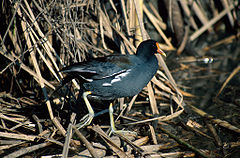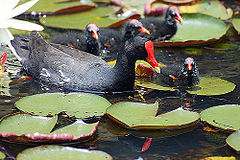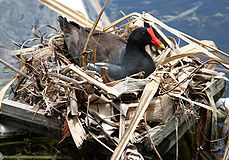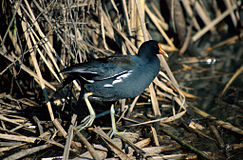- Common Gallinule
-
Common Gallinule 
Common Gallinule Conservation status Scientific classification Kingdom: Animalia Phylum: Chordata Class: Aves Subclass: Neornithes Infraclass: Neognathae Superorder: Neoaves Order: Gruiformes Family: Rallidae Genus: Gallinula Species: G. galeata Binomial name Gallinula galeata About 6, see text
Synonyms Gallinula brodkorbi McCoy, 1963
The Common Gallinule, (Gallinula galeata) is a North American bird in the Rallidae family which has recently been split from the Common Moorhen by the AOU in July 2011.[1] It lives around well-vegetated marshes, ponds, canals and other wetlands. The species is not found in the polar regions, or many tropical rainforests. But elsewhere the Common Gallnule is likely the most commonly seen rail species in much of North America, excepting the American Coot in some regions.
Contents
Description and ecology
The Gallinule has dark plumage apart from the white undertail, yellow legs and a red facial shield. The young are browner and lack the red shield. It has a wide range of gargling calls and will emit loud hisses when threatened.[2]
This is a common breeding bird in marsh environments and well-vegetated lakes. Populations in areas where the waters freeze, such as southern Canada, and the northern USA, will migrate to more temperate climes. This species will consume a wide variety of vegetable material and small aquatic creatures. They forage beside or in the water, sometimes upending in the water to feed. It is often secretive, but can become tame in some areas. Despite loss of habitat in parts of its range, the Common Gallinule remains plentiful and widespread. They fight over territories and also hop around Lily pads.
The nest is a basket built on the ground in dense vegetation. Laying starts in spring, between mid-March and mid-May in N hemisphere temperate regions. About 8 eggs are usually laid per female early in the season; a brood later in the year usually has only 5-8 or even less eggs. Nests may be re-used by different females. Incubation lasts about three weeks. Both parents incubate and feed the young. These fledge after 40–50 days, become independent usually a few weeks thereafter, and may raise their first brood the next spring. When threatened, the young may cling to the parents' body, after which the adult birds fly away to safety, carrying their offspring with them.[3]
The Common Gallinule is as abundant as its vernacular name implies. It is therefore considered a species of Least Concern by the IUCN.[4]
This species is parasitised by the moorhen flea, Dasypsyllus gallinulae.[5]
Subspecies
In addition to the nominate form, there are Pleistocene populations known from fossils; they were distinct (generally larger) birds and probably the direct ancestors of some of today's Common Moorhens: The stout and long-winged paleosubspecies G. c. brodkorbi is known from the Ichetucknee River deposits in Florida; it was originally described as a distinct species. The presence of fossils typical of the shorter-winged and more delicate G. c. cerceris in the same deposits suggests that brodkorbi was not ancestral to the "Florida Gallinule" of our time but rather to the more northernly "Common Gallinule".
List of subspecies by date of description Common and
trinomial namesDescription Range Southern American Common Gallinule
G. g. galeata (Lichtenstein, 1818)
Wings and back are fairly uniform dark brownish slate grey. Found in Trinidad, the Guyanas, and from Brazil south of the Amazonas to North Argentina and Uruguay. Andean Common Gallinule
G. g. garmani (Allen, 1876)Similar to galeata, but larger. Found in the Andes from Peru to Northwest Argentina. Antillean Common Gallinule
G. g. cerceris (Bangs, 1910)
Known as Florida Gallinule in the USA.[6]
Has a long bill and large feet and is less brown above. Found in the Antilles, except Trinidad and Barbados; also found in South Florida. North American Common Gallinule
G. g. cachinnans (Bangs, 1915)
Also known as Common Gallinule and Marsh Hen.
Similar to cerceris, but upperparts coloration more like chloropus. Ranges from Southeast Canada south through the USA, excluding the Great Plains region, to West Panama; also found in the Galápagos and Bermuda. Subandean Common Gallinule
G. g. pauxilla (Bangs, 1915)Similar to cerceris, but smaller. Found in lowland areas of East Panama south to Northwest Peru. Barbados Gallinule
G. g. barbadensis (Bond, 1954)Similar to cerceris, but with lighter head and neck, and less dull grey overall. Endemic to Barbados. Footnotes
- ^ Chesser et.al. (2011)
- ^ Snow et al. (1998)
- ^ Mann (1991), Snow et al. (1998)
- ^ BLI (2008)
- ^ Rothschild, Miriam; Clay, Theresa (1953). Fleas, Flukes and Cuckoos. A study of bird parasites. London: Collins. pp. 113. http://ia331318.us.archive.org/1/items/fleasflukescucko017900mbp/fleasflukescucko017900mbp.pdf.
- ^ Due to uncertainty about the Floridan birds' taxonomic identity, this vernacular name was also applied to ssp. galeata and cachinnans.
References
- Chesser, R. Terry, Richard C. Banks, F. Keith Barker, Carla Cicero, Jon L. Dunn, Andrew W. Kratter, Irby J. Lovette, Pamela C. Rasmussen, J. V. Remsen, James D. Rising, Douglas F. Stotz, Kevin Winker. 2011. Fifty-second supplement to the American Ornithologists' Union Check-List of North American Birds. Auk 128(3):600-613.
- Dronen, Norman O.; Gardner, Scott L. & Jiménez, F. Agustín (2006): Selfcoelum limnodromi n. gen., n. sp. (Digenea: Cyclocoelidae: Cyclocoelinae) from the long-billed dowitcher, Limnodromus scolopaceus (Charadriiformes: Scolopacidae) from Oklahoma, U.S.A.. Zootaxa 1131: 49–58. PDF fulltext
- McCoy, John J. (1963): The fossil avifauna of Itchtucknee [sic] River, Florida. Auk 80(3): 335–351. DjVu fulltext PDF fulltext
- Olson, Storrs L. (1974): The Pleistocene Rails of North America. Condor 76(2): 169-175. DjVu fulltext PDF fulltext
External links
Categories:- IUCN Red List least concern species
- Gallinula
- Rails
- Birds of Puerto Rico
- Birds of North America
Wikimedia Foundation. 2010.


